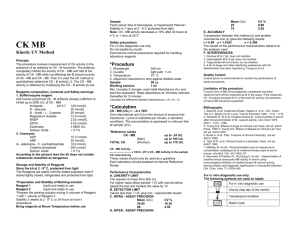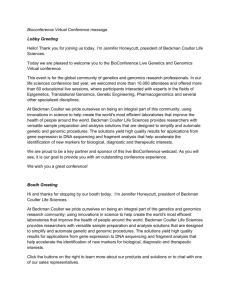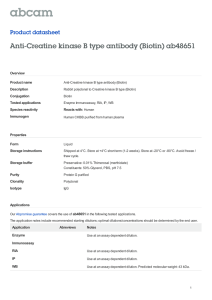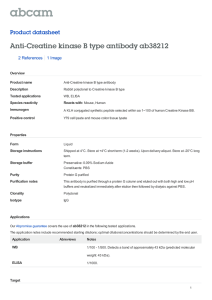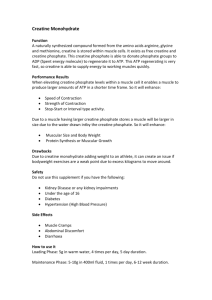CREATINE KINASE (CK-Nac)
advertisement
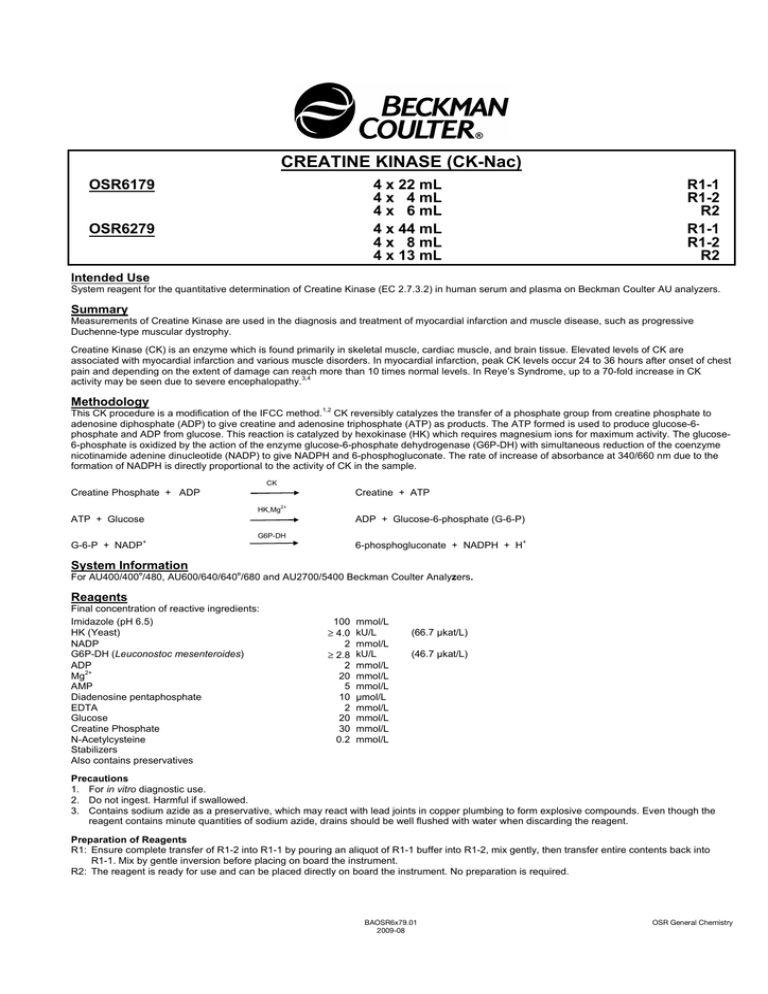
CREATINE KINASE (CK-Nac) OSR6179 4 x 22 mL 4 x 4 mL 4 x 6 mL 4 x 44 mL 4 x 8 mL 4 x 13 mL OSR6279 R1-1 R1-2 R2 R1-1 R1-2 R2 Intended Use System reagent for the quantitative determination of Creatine Kinase (EC 2.7.3.2) in human serum and plasma on Beckman Coulter AU analyzers. Summary Measurements of Creatine Kinase are used in the diagnosis and treatment of myocardial infarction and muscle disease, such as progressive Duchenne-type muscular dystrophy. Creatine Kinase (CK) is an enzyme which is found primarily in skeletal muscle, cardiac muscle, and brain tissue. Elevated levels of CK are associated with myocardial infarction and various muscle disorders. In myocardial infarction, peak CK levels occur 24 to 36 hours after onset of chest pain and depending on the extent of damage can reach more than 10 times normal levels. In Reye’s Syndrome, up to a 70-fold increase in CK 3,4 activity may be seen due to severe encephalopathy. Methodology 1,2 This CK procedure is a modification of the IFCC method. CK reversibly catalyzes the transfer of a phosphate group from creatine phosphate to adenosine diphosphate (ADP) to give creatine and adenosine triphosphate (ATP) as products. The ATP formed is used to produce glucose-6phosphate and ADP from glucose. This reaction is catalyzed by hexokinase (HK) which requires magnesium ions for maximum activity. The glucose6-phosphate is oxidized by the action of the enzyme glucose-6-phosphate dehydrogenase (G6P-DH) with simultaneous reduction of the coenzyme nicotinamide adenine dinucleotide (NADP) to give NADPH and 6-phosphogluconate. The rate of increase of absorbance at 340/660 nm due to the formation of NADPH is directly proportional to the activity of CK in the sample. CK Creatine Phosphate + ADP Creatine + ATP HK,Mg2+ ATP + Glucose G-6-P + NADP G6P-DH + System Information e ADP + Glucose-6-phosphate (G-6-P) 6-phosphogluconate + NADPH + H + e For AU400/400 /480, AU600/640/640 /680 and AU2700/5400 Beckman Coulter Analyzers. Reagents Final concentration of reactive ingredients: Imidazole (pH 6.5) HK (Yeast) NADP G6P-DH (Leuconostoc mesenteroides) ADP 2+ Mg AMP Diadenosine pentaphosphate EDTA Glucose Creatine Phosphate N-Acetylcysteine Stabilizers Also contains preservatives 100 ≥ 4.0 2 ≥ 2.8 2 20 5 10 2 20 30 0.2 mmol/L kU/L mmol/L kU/L mmol/L mmol/L mmol/L µmol/L mmol/L mmol/L mmol/L mmol/L (66.7 µkat/L) (46.7 µkat/L) Precautions 1. For in vitro diagnostic use. 2. Do not ingest. Harmful if swallowed. 3. Contains sodium azide as a preservative, which may react with lead joints in copper plumbing to form explosive compounds. Even though the reagent contains minute quantities of sodium azide, drains should be well flushed with water when discarding the reagent. Preparation of Reagents R1: Ensure complete transfer of R1-2 into R1-1 by pouring an aliquot of R1-1 buffer into R1-2, mix gently, then transfer entire contents back into R1-1. Mix by gentle inversion before placing on board the instrument. R2: The reagent is ready for use and can be placed directly on board the instrument. No preparation is required. BAOSR6x79.01 2009-08 OSR General Chemistry Creatine Kinase (CK-Nac) Storage and Stability 1. The unopened reagents are stable until the expiration date printed on the label when stored at 2 – 8°C. 2. Opened reagents are stable for 30 days when stored in the refrigerated compartment of the analyzer. Indications of Deterioration Visible signs of microbial growth, turbidity, precipitate, or any change in reagent color may indicate degradation and warrant discontinuance of use. Specimen Collection and Preparation Serum and heparinized plasma samples free from hemolysis are the recommended specimens. Allow specimen to clot. Remove serum from cells promptly to minimize hemolysis and contamination by adenylate kinase from the red cells. Plasma samples may occasionally produce unpredictable 1 rate reactions resulting in false low results. Plasma with EDTA, oxalate or citrate is not recommended. Sample Storage and Stability 3 Protect samples from light for maximum stability. CK is stable in serum for 4 hours at 15 - 25°C, 8 - 12 hours at 2 - 8°C or 1 month at ≤ -20°C. Interfering Substances 5 Results of studies show that the following substances interfere with this creatine kinase assay. The criteria for no significant interference is recovery within 10% of the initial value. Bilirubin: Hemolysis: Lipemia: No significant interference up to 40 mg/dL Bilirubin No significant interference up to 500 mg/dL Hemolysate No significant interference up to 1000 mg/dL Intralipid* * Intralipid, manufactured by KabiVitrium Inc., is a 20% IV fat emulsion used to emulate extremely turbid samples. The information presented is based on results from Beckman Coulter studies and is current at the date of publication. Beckman Coulter Inc. makes no representation about the completeness or accuracy of results generated by future studies. For further information on interfering substances, refer 6 to Young for a compilation of reported interferences with this test. Procedure A complete list of test parameters and operational procedure can be found in the User’s Guide appropriate to the analyzer. Materials Provided CK Reagent Stability of Final Reaction Mixture The Beckman Coulter AU analyzer automatically computes every determination at the same time interval. Calibration Calibration of this creatine kinase procedure is based upon the theoretical extinction coefficient for NADPH, which has a molar absorptivity of 6300 at 340/660 nm. Quality Control During operation of the Beckman Coulter AU analyzer at least two levels of an appropriate quality control material should be tested a minimum of once a day. In addition, controls should be performed with each new lot of reagent, after specific maintenance, or troubleshooting steps described in the appropriate User’s Guide. Quality control testing should be performed in accordance with regulatory requirements and each laboratory’s standard procedure. Results Automatically printed out for each sample in U/L at 37°C. Dynamic Range The CK procedure is linear from 10 to 2000 U/L. Samples exceeding the upper limit of linearity should be diluted and repeated. The sample may be diluted, repeated, and multiplied by the dilution factor automatically utilizing the AUTO REPEAT RUN. Expected Values 7 Adults: 30 - 223 U/L Expected values may vary with age, sex, diet, and geographical location. Each laboratory should determine its own expected values as dictated by good laboratory practice. Specific Performance Characteristics The following data was obtained using the CK Reagent on Beckman Coulter AU analyzers according to established procedures. Results obtained in individual laboratories may differ. 9 Precision 8 Estimates of precision, based on CLSI recommendations , are consistent with typical performance. The within run precision is less than 5% CV and total precision is less than 10% CV. Assays of control sera were carried out and data reduced following CLSI guidelines above. N= 80 Within run Total Mean (U/L) SD CV% SD CV% 117 1.22 1.00 1.77 1.50 135 2.04 1.50 3.83 2.80 452 4.85 1.10 11.47 2.50 498 5.44 1.10 9.94 2.00 OSR General Chemistry BAOSR6x79.01 2009-08 Creatine Kinase (CK-Nac) 9 Method Comparison Patient samples were used to compare this CK Reagent. The table below demonstrates representative performance on AU analyzers. Y Method X Method Slope Intercept Correlation Coeff. (r) No. of Samples (n) Range (U/L) e AU640 Method 2 0.997 0.392 0.9997 103 20 - 584 Sensitivity Typical change in absorbance per minute for 1 U/L of CK is 0.12 mAbsorbance. References 1. 2. 3. 4. 5. 6. 7. 8. 9. Horder M., Elsner R., et al., Approved Recommendation of IFCC Methods for the Measurement of Catalytic Concentration of Enzymes, Part 7 IFCC Method for Creatine Kinase. J. Clin. Chem. Clin. Biochem. 29, 435, 1991. Szasz, G., Gerhardt, W. and Gruber, W., Clin Chem, 23: 1888, 1977. Tietz, N.W. (ed), Fundamentals of Clinical Chemistry, 3rd Edition, W.B. Saunders, 1987. Tietz, N.W., (ed), Clinical Guide to Laboratory Tests, 3rd Edition, W.B. Saunders, 1995. CLSI/NCCLS, Interference Testing in Clinical Chemistry EP7-P, 1986. Young, D.S., Effects of Drugs on Clinical Laboratory Tests, 5th Edition, AACC Press, 2000. Beckman Coulter Inc. data on samples collected from 200 blood donors in North Texas. CLSI/NCCLS Evaluation Protocol, EP5-A, 1999. Data is on file for specific AU analyzers. Manufactured by: Beckman Coulter, Inc., 250 S. Kraemer Blvd. Brea, CA 92821, USA BAOSR6x79.01 2009-08 OSR General Chemistry

